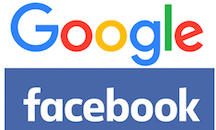Google and Facebook Must Adopt Responsible Practices Regarding Role in Political Campaigns

What can marketers learn from the latest data about voter behavior online?
Voters make decisions before they’re in the booth—by going online. To understand the influence of digital media and online video in the 2016 elections, Google partnered with two leading political consultants to survey primary voters. Here, they discuss what the results mean for marketers.
This election cycle, people are increasingly going online before going to the polls. In the first two months of the year, the average registered voter gearing up for Super Tuesday researched the primary election online 85 times. And in just the last year, people have watched over 110M hours of candidate- and issues-related video on YouTube.
To learn more about how registered voters educate themselves on the facts, candidates, and issues before the primaries, Google partnered with political consultants Julie Hootkin and Dr. Frank Luntz. As executive vice president at Global Strategy Group (GSG), Julie has been a consultant to members of Congress, governors, and mayors across the United States, and leads her firm’s corporate impact practice, which helps businesses navigate the issues of the day. A preeminent pollster, Frank has been featured on major broadcast networks and is the founder of Luntz Global Partners, which consults Fortune 500 companies and political campaigns alike.
How is voter behavior in this election cycle different from four years ago?
Dr. Frank Luntz: As of this year, people are spending 40% more time online than on TV. Think about that. They know that digital platforms, whether desktop or mobile—from news websites to Google Search to YouTube—deliver far more convenience than traditional media.
In political campaigns, television is still powerful, but voters believe it provides too much spin, too many half-truths, and too little detail. Digital empowers voters to find the precise information and facts they’re seeking. They decide the search terms, the content, the time, the length, and well, everything else. As one Iowa Republican voter in our focus group said, “We’re more informed than we’ve ever been because of the internet.”
We also see this in campaigns for consumer products, financial services, and every other category brand marketers care about.
Today’s voters are spending more time online, almost two hours for every hour spent watching TV.
Julie Hootkin: We’re living in an on-demand world. With just the touch of a button, we can watch a movie, order groceries, and hail a cab. Just as easily, we can visit a candidate’s website, watch a campaign video on YouTube, and fact-check a candidate’s position on Google.
People are “on” 24/7, thanks in large part to their smartphones. For political campaigns, this means today’s voters are more connected than ever before. They are spending more time online, almost two hours for every hour spent watching TV, and they are increasingly relying on their mobile devices to provide them with answers to their questions in real-time. Almost 60% of elections-related searches are now coming from mobile devices, representing nearly 3X growth since the last presidential election cycle.
As a result, campaigns—and brands—have an unprecedented number of opportunities to inform, engage, and persuade voters through digital communications.
How are voters engaging online vs. with traditional media?
Julie Hootkin: Sometimes it feels like we are trapped in a debate that pits traditional against digital, but the truth of the matter is, it’s not a zero-sum game. This goes for both political campaigns and brand marketing: TV is good for some things, and digital is good for others.
TV continues to play an important role in introducing candidates to voters, particularly early on in the campaign cycle. But as voters move through the decision-making process and Election Day approaches, digital plays an increasingly important role. Why? We heard from a lot of voters that they don’t feel like they get the full story from TV—anyone who’s ever written an ad script can tell you, you can only fit about 76 words in a 30-second spot. Voters want more, and they find it online (link is external).
People will watch content that matters to them—regardless of length.
Dr. Frank Luntz: Voters generally dislike and distrust the over-the-top negative political ads they see on television. Don’t get me wrong—they still make an impact. But the 30-second or 60-second spot is not as persuasive and informative as it once was. As an Iowa Democratic voter in our focus group put it, “TV ads don’t tell you enough. They’re a good starting point, but they’re not a good way to make a decision.”
That’s why voters turn to search, news sites, candidate sites, and YouTube to find the full, unedited story and unbiased facts for themselves.
—-
For the full article written by Kate Stanford, Director of YouTube Advertiser Marketing of Google, visit http://bit.ly/24Unrti (link is external)
